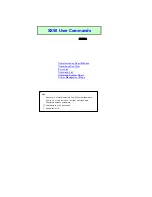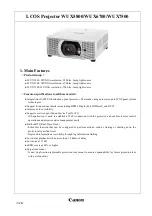
5. ICMP
Digital Cinema Package (DCP)
A Digital Cinema Package (DCP) is a collection of digital
fi
les used to store and convey Digital Cinema (DC) audio,
image, and data streams. The term has been de
fi
ned by Digital Cinema Initiatives (DCI). General practice adopts a
fi
le
structure that is organized into a number of usually multi-gigabyte size Material eXchange Format (MXF)
fi
les, which
are separately used to store audio and video streams, and auxiliary index
fi
les in XML format. The MXF
fi
les contain
streams that are compressed, encoded, and encrypted, in order to reduce the huge amount of required storage and
to protect from unauthorized use. The image part is JPEG 2000 compressed, whereas the audio part is linear PCM.
The adopted (optional) encryption standard is AES 128 bit in CBC mode. The newer SMPTE standards are used to
conform the recommendations among different tool vendors and producers. Interop, the legacy DCP standard, is still
required to be supported by DCP players.
Digital Cinema Initiatives (DCI)
DCI is a joint venture of Disney, Fox, Paramount, Sony Pictures Entertainment, Universal and Warner Bros. Studios.
DCI’s primary purpose is to establish and document voluntary speci
fi
cations for an open architecture for digital cin-
ema that ensures a uniform and high level of technical performance, reliability and quality control. Note that the DCI
speci
fi
cation is not a standard. Standards for digital cinema are the domain of the Society of Motion Picture and Tele-
vision Engineers (SMPTE). "DCI compliant" is a term used to describe products that conform to the DCI speci
fi
cation.
Products that have been tested per the DCI Compliance Test Plan (CTP) are posted at the DCI compliance web site.
Notably, DCI compliance does not require compliance to the full set of SMPTE DCP standards. A copy of the most
recent DCI speci
fi
cation can be downloaded from the DCI website (
http://dcimovies.com
).
5.12 ICMP con
fi
guration via Communicator
About ICMP con
fi
guration
Following parameters are available to con
fi
gure the ICMP:
•
Global settings: allows de
fi
ning name of the ICMP, host name (network identi
fi
er) and IP address which can be used for com-
munication with external content devices.
•
User settings: de
fi
nition of all users allowed on the ICMP.
•
Server settings: de
fi
nition of access to servers and storage libraries of content (movies, KDM, etc.).
•
Player settings: Audio delay and audio output frequency.
•
Audio channel: allows de
fi
ning the mapping of audio channels (content) on each audio output (AES outputs of the ICMP).
•
Scheduler setting: Enable/Disable scheduler at startup, delays allowed in scheduler mode and length of schedule history.
•
Devices: allows de
fi
ning communication ports settings, to access external devices controlled by the automation.
•
Automation Cues: event cues that are triggered from different sources and to which can be assigned actions to be executed
by the automation engine.
•
Verify internal clock of the ICMP.
All installation and maintenance operations on the ICMP are performed via Communicator, the Barco con
fi
g-
uration software. Please refer to the Communicator user guide for further information.
About Default settings
The restore of factory setting is a feature that allows removing all settings performed on the ICMP and replaces them with the default
values set at the factory. Please refer to the Communicator user guide for further information.
About the ICMP internal clock
The crystal on the ICMP board that manages the clock shows a certain drift (all crystals do). With the Communicator the internal
clock can be adjusted. This maintenance action should be repeated every 3 months. When neglected the system will locks up.
From ICMP software version 1.2.1 onwards it is possible to enable NTP (Network Time Protocol). You have to con
fi
gure (at instal-
lation) an IP address where the ICMP can
fi
nd a sync signal. From then on, and as long as the connection is active, the ICMP will
automatically keep its clock correct. For detailed instructions see user guide of the Communicator.
50
R5906787 THOR 26/01/2018
Summary of Contents for Thor
Page 1: ...Thor User manual R5906787 02 26 01 2018...
Page 6: ...Table of contents 2 R5906787 THOR 26 01 2018...
Page 8: ...1 Welcome 4 R5906787 THOR 26 01 2018...
Page 26: ...3 Lenses Lens selection 22 R5906787 THOR 26 01 2018...
Page 34: ...4 Input Communication 30 R5906787 THOR 26 01 2018...
Page 62: ...6 Starting up 58 R5906787 THOR 26 01 2018...
















































